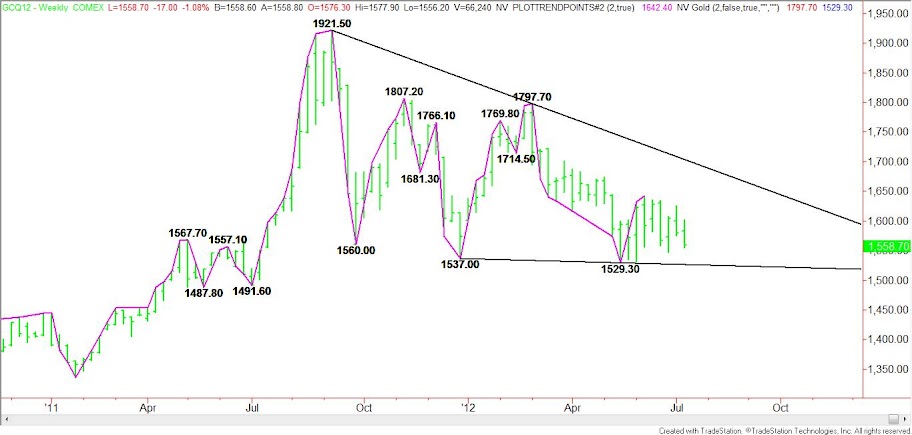Earlier in the week, the U.S. Federal Reserve gave the dollar a boost when its FOMC minutes indicated to market participants that is was not planning to implement any additional stimulus to boost the U.S. economy. This provided traders with confirmation that every major central bank was easing with the exception of the U.S. Federal Reserve.
Equity and commodity markets had been trading close to their near-term highs in anticipation of better news, but once the minutes were released, investors were encouraged to lighten up on their long positions in higher risk equities and commodities.
Since the Fed meets on July 31 and August 1, investors are encouraged to pay close attention over the next two weeks to economic reports since this same information will be used by the FOMC members to make their next decision on additional stimulus. Any shift in direction will be in keeping with the Fed’s statement to stand ready to provide additional stimulus when necessary.
In the meantime, traders should be aware of the effect the stronger dollar has on currencies, equities and commodities. Interest rates ultimately drive all markets so when one central bank is raising rates and another is holding rates steady or easing, money will flow into the currency offering the better rate of return. In other words, money will seek the highest level of return.
This explains why traders are favoring the U.S. Dollar over the Euro and the British Pound for example. As for its effect on commodity prices, commodity markets priced in dollars get more expensive when the dollar rises. Higher prices will often lead to lower demand so demand sensitive markets like crude oil typically go down in value.
Gold will also usually lose value when the dollar rises. This is based on the theory that investors want to hold paper or hard assets. This is pretty close to the theory that investors buy or sell close based on the inflation outlook for an economy. For a prolonged period of time while inflation has been under control according to the Fed, investors have been treating gold as both a reserve currency and an investment.
Recommended
Those looking at gold as a reserve currency typically sell it when the dollar rises. Those investing in gold to generate a positive return will buy it when it gets relatively cheap and sell it when it is expensive.
The following charts will demonstrate the U.S. Dollar’s influence on a few related markets.
The U.S. Dollar resumed its uptrend this week when it took out the June 1, 2012 top at 83.54. This move solidified a new bottom at 81.19. As long as this higher-top, higher-bottom trading continues to take place, investors should look for more upside movement.
 This chart of the EUR/USD shows that the Euro has been gradually losing strength against the U.S. Dollar since May 2011. The downtrend is clearly defined by the series of lower-tops and lower-bottoms. This chart indicates that the Euro is likely to continue to fall until the chart pattern is broken. The longer-term charts suggest that 1.1876 or the June 2010 bottom is the next likely downside target.
This chart of the EUR/USD shows that the Euro has been gradually losing strength against the U.S. Dollar since May 2011. The downtrend is clearly defined by the series of lower-tops and lower-bottoms. This chart indicates that the Euro is likely to continue to fall until the chart pattern is broken. The longer-term charts suggest that 1.1876 or the June 2010 bottom is the next likely downside target.
 The Weekly August Gold chart shows a clearly defined descending triangle chart pattern. The descending triangle is a non-trending pattern. This is because the gradual narrowing of the resistance line combines with the flat support line to compress the weekly price ranges. Typically, the longer the market remains inside of this compressed zone, the greater the volatility on the breakout. If the U.S. Dollar continues on its higher path then traders should watch for a possible break through the support at $1529.30. This move could lead to an acceleration to the downside.
The Weekly August Gold chart shows a clearly defined descending triangle chart pattern. The descending triangle is a non-trending pattern. This is because the gradual narrowing of the resistance line combines with the flat support line to compress the weekly price ranges. Typically, the longer the market remains inside of this compressed zone, the greater the volatility on the breakout. If the U.S. Dollar continues on its higher path then traders should watch for a possible break through the support at $1529.30. This move could lead to an acceleration to the downside.
 Looking at the rally in the U.S. Dollar and its affect on the Euro and gold demonstrates how much influence the U.S. Federal reserve can have on currency and commodity markets. With the Fed scheduled to meet July 31 – August 1, the Euro and gold are two markets that should be watch closely for opportunity.
Looking at the rally in the U.S. Dollar and its affect on the Euro and gold demonstrates how much influence the U.S. Federal reserve can have on currency and commodity markets. With the Fed scheduled to meet July 31 – August 1, the Euro and gold are two markets that should be watch closely for opportunity.
Traders should watch the economic reports closely over the next two weeks to get an idea of what the Fed members will be looking at when they make their next policy decision. If the economy continues to weaken at an accelerated pace then the Fed may opt to implement a more aggressive form of stimulus, this could help form a top in the Dollar and bottoms in the Euro and gold.





















Join the conversation as a VIP Member